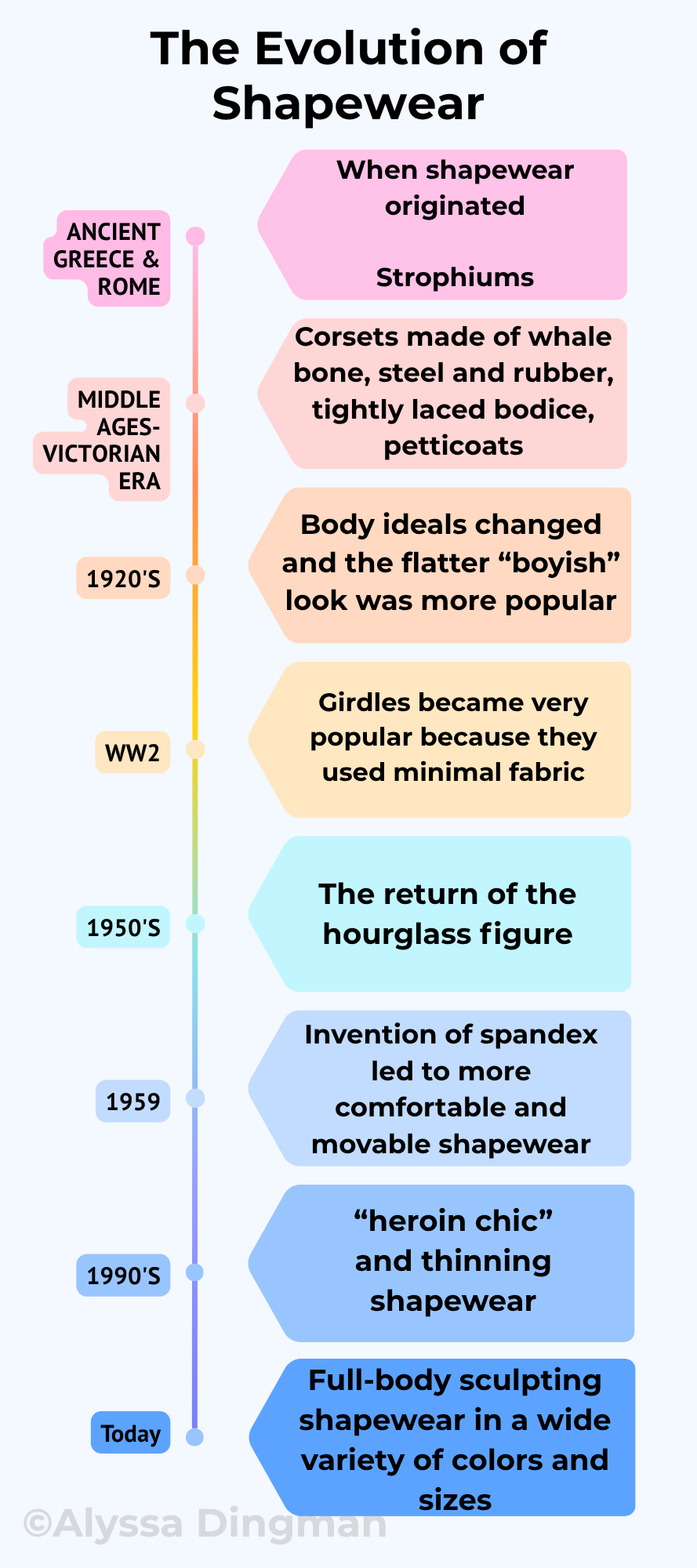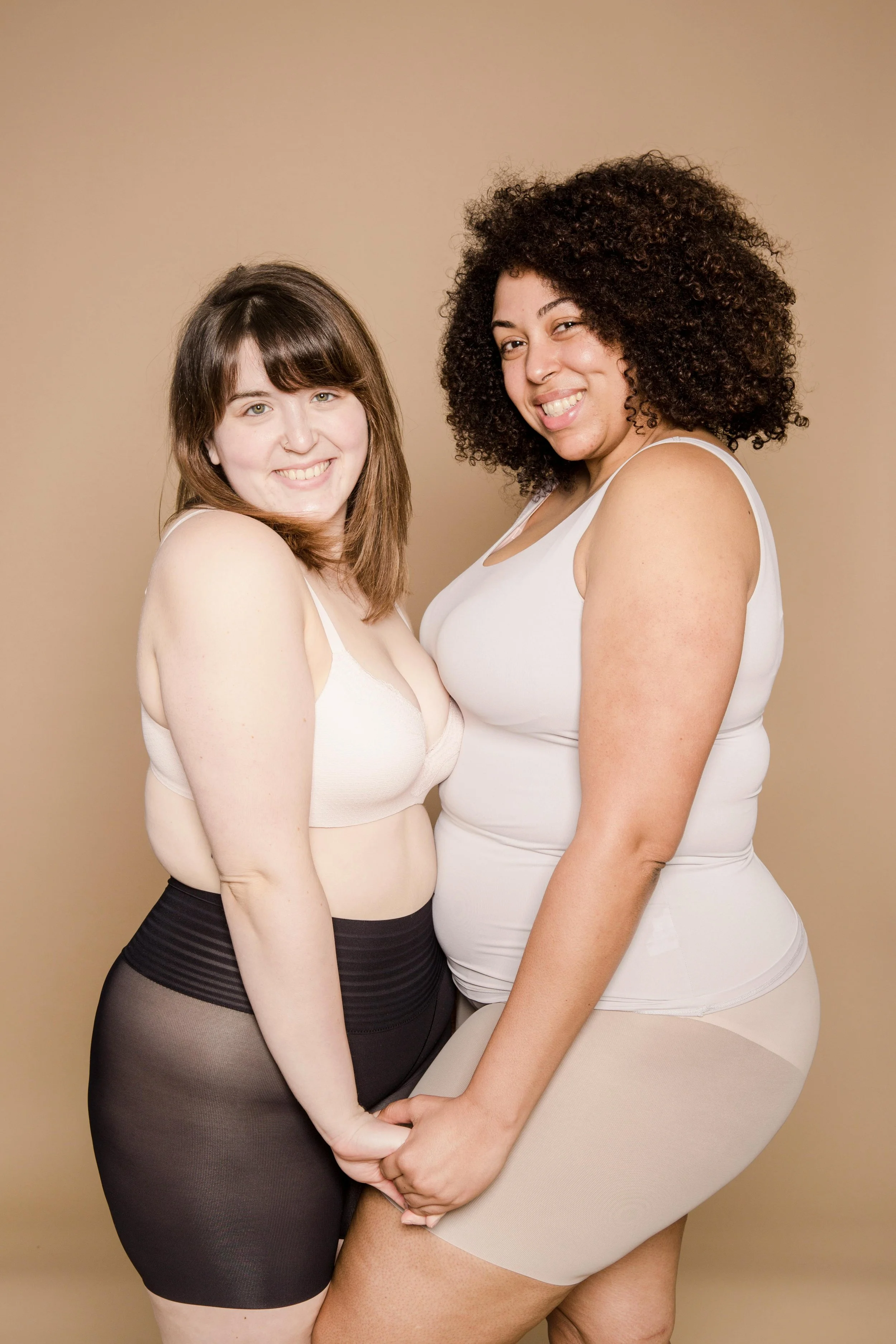The History of Shapewear: From Ancient Times to Today
Image by Karen Arnold via publicdomainpictures.net, image via rawpixel.com, image by David Ring via commons.wikimedia.org, image by laning via favpng.com, image by Karen Arnold via publicdomainpictures.net
Have you ever worn leggings, a bodysuit, or Spanx? These are all kinds of shapewear that are made to smooth and shape our bodies. Shapewear has been around for a very long time. People have been finding ways to shape their bodies since ancient times. The styles and reasons have changed, but one thing has stayed the same, people want to feel confident in their bodies and in what they wear.
Let’s take a trip through time to see how shapewear has changed from ancient Greece and Rome all the way to modern days!
Shapewear has always existed, but it has evolved over time due to the many trends in women’s fashion over the years.
Ancient Greece and Rome: The First Shapewear
Long, long ago, in ancient Greece and Rome, people already had early kinds of shapewear.
Women in Greece wore a piece of cloth called a strophium. It was like a long band that wrapped around the chest, similar to a bandeau bra. It helped give support and shape, just like a bra does today.
These early forms of shapewear weren’t as tight or structured as what came later. People didn’t use metal or laces yet. Still, they showed that even thousands of years ago, people cared about how their bodies looked in clothes.
In ancient times, shapewear wasn’t just about beauty, it was also about function. Women wore it to keep their clothes in place while walking, dancing, or working. The idea of supporting and shaping the body started here and never really went away.
The Middle Ages: Layers and Long Dresses
After ancient times came the Middle Ages, when people wore long gowns and heavy clothing. Women wanted to look smooth and neat under all those layers.
During this time, shapewear looked very different. There were no stretchy fabrics or zippers. Instead, women wore long undergarments made from linen or cotton. These layers helped keep outer dresses clean and made the body look smoother.
It was also the start of tightly laced bodice, which made the waist unnaturally small and lifted breasts. This was extremely uncomfortable and not healthy.
Image by Charmaine Zoe via flickr.com
The Victorian Era: The Rise of the Corset
Fast forward to the Victorian era in the 1800s — this was the age of the corset.
Corsets were made with steel or whale bone and were tied very tightly around the waist. The goal was to make the waist look tiny and the chest and hips look full. This created the famous hourglass figure — a shape that many people thought was the perfect symbol of beauty and womanhood.
Women wore corsets under their dresses every single day. Some even started wearing them as girls. Some women could barely breathe or move easily because of how tight their corsets were.
Corsets also showed social status. A woman with a tiny waist was seen as rich or refined because she didn’t have to do hard labor.
Under the corset, women often wore petticoats; long, fluffy skirts that made dresses look full and fancy. Together, the corset and petticoats made women’s fashion look elegant but also quite restrictive.
Even though corsets caused health problems, like back pain and trouble breathing, they stayed popular for many years. People believed beauty was worth the pain.
Image by Karen Arnold via publicdomainpictures.net
The 1920s: A Big Change in Shape and Style
After hundreds of years of corsets, things changed in the 1920s and fashion took a new direction.
The world was changing fast. Women were working more, voting, and enjoying new freedoms after World War I. They didn’t want heavy, tight corsets anymore.
Instead, they wanted clothes that let them move, dance, and breathe.
The new style was called the flapper look. It was slim and straight, with little curves. Instead of shaping their bodies into an hourglass, women now wanted to look flat and “boyish”.
Therefore, shapewear also changed. Corsets turned into girdles and bandeaus which were stretchy, lighter garments that smoothed the body but didn’t squeeze it. These new undergarments focused on slimming the figure, not shaping it into curves.
The 1920s were all about freedom and fun. Women could finally wear clothes that fit their lifestyles, not just .
Image by genibee via flickr.com
The 1940s: Girdles and World War II
When World War II began in the 1940s, fashion changed again. Because of the war, there were fabric shortages. People had to make do with less material, so clothing designs became simpler.
Girdles became very popular during this time. They used less fabric than older shapewear but still helped smooth the body under tight skirts and dresses.
Girdles were also easier to wear than corsets — they didn’t use steel or bone, just elastic materials. This made them more comfortable for everyday use.
The 1950s: The Hourglass Comes Back
In the 1950s, the hourglass figure made a big comeback. Designers like Christian Dior created dresses with tiny waists, full skirts, and soft, curvy shapes. Once again, women wanted that “perfect” silhouette.
Shapewear became a key part of achieving this look. Girdles and waist cinchers helped pull in the waist and lift the bust. But now, these undergarments were softer and more flexible than the old steel corsets.
Instead of pain and pressure, 1950s shapewear was designed to be flattering and comfortable. It gave women the look they wanted without feeling trapped.
This decade also introduced new fabrics that stretched and breathed, making shapewear easier to wear all day. It was a mix of old and new — the classic hourglass shape, but with modern comfort.
The 1960s and Beyond: Spandex Changes Everything
In the 1960s, spandex was invented.
Spandex (also known as Lycra) and polyester were brand-new materials that stretched easily and returned to their original shape. This made shapewear lightweight, stretchy, and soft, which was much better than stiff girdles.
These new fabrics allowed designers to create shapewear that moved with the body instead of against it. It also meant that shapewear could be hidden under clothes and no more bulky layers.
By the 1970s and 1980s, fashion was changing fast. Women started wearing pants, jeans, and activewear, so shapewear wasn’t needed for everyday wear anymore. Comfort and mobility became more important than squeezing into a specific shape.
People started to believe that every body was beautiful in its own way, not just one ideal type.
The 1990s: Slimming Styles and “Heroin Chic”
The 1990s brought a new beauty trend that changed fashion again. The look was called “heroin chic.”
This style was all about looking very slim, pale, and effortless. Models like Kate Moss made the thin, minimalist look famous.
Because the 1990s beauty trend focused on being very slim, shapewear became sleek and invisible. It wasn’t about curves or volume anymore — it was about smoothing the body under tight clothes and keeping lines flat.
Shapewear was made from thin, stretchy materials like spandex and nylon. It was meant to be hidden under clothes, not seen.
This decade focused on slimming shapewear — helping people look smaller and smoother, not curvier.
But as the 1990s ended, so did “heroin chic”.
The 2000s and 2010s: Spanx and Body Confidence
In the early 2000s, shapewear became popular again, but this time, it was all about confidence and comfort.
A woman named Sara Blakely invented Spanx, a new kind of shapewear made from super-stretchy fabric that smoothed the body without tightness or discomfort.
Spanx became a huge hit. Celebrities wore it, and women everywhere loved how it made their clothes fit better.
Shapewear now came in many forms — shorts, leggings, bodysuits, and tanks. It was no longer just underwear; it was part of everyday fashion.
Instead of hiding your body, shapewear became a tool to enhance your natural features.
Image by Laura Tancredi via pexels.com
Shapewear Today: Comfort, Confidence, and SKIMS
Today, shapewear is bigger than ever, but it’s not about squeezing or hiding anymore.
Modern brands like SKIMS, founded by Kim Kardashian, focus on body positivity, comfort, and inclusivity.
SKIMS shapewear is soft, smooth, and stretchy. It comes in a variety of many different skin tones and sizes, so everyone can find their perfect fit. It’s designed to move with your body, not against it.
Other brands have followed this idea too, making shapewear that fits every shape, every size, and every body.
Modern shapewear is made with advanced materials that cool your skin, stretch in every direction, and even feel like a second layer of skin.
How Shapewear Reflects Beauty Ideals
When we look at the history of shapewear, we can see how it always matches what people think is beautiful at the time.
In ancient times, shapewear was about support.
In the Victorian era, it was about a tiny waist.
In the 1920s, it was about being slim and boyish.
In the 1950s, it was about being curvy again.
And today, it's about enhancing your natural figure.
Each time period tells a story about what people valued — not just in fashion, but in life.
In the past, shapewear often represented rules or expectations about how women should look, even though these expectations were unnatural. But today, it’s becoming a tool for self-expression and comfort in one's body.
Shapewear now helps people feel strong and stylish on their own terms.
References:
OpenAI.2025.ChatGPT.Nov 4 Version[Large language model].https://chatgpt.com
The history of shapewear: From steel corsets to shapewear made to be s. Pinsy Shapewear. (2023, February 23). https://wearpinsy.com/blogs/the-pinsy-post/the-history-of-shapewear-from-steel-corsets-to-contemporary-looks?srsltid=AfmBOoo7K26bg7HySmz_ljFBq2FFs5PCIS94Tn9Y5jEdlA32LvEEilqJ
Matthew, R. (2024, June 9). From curves to contours: The evolution of shapewear through the ages. Robert Matthew. https://robertmatthew.com/blogs/rm-insider/from-curves-to-contours-the-evolution-of-shapewear-through-the-ages





